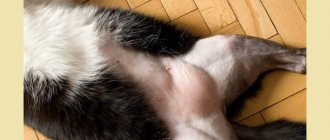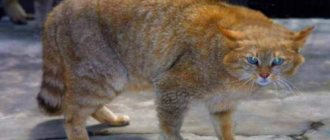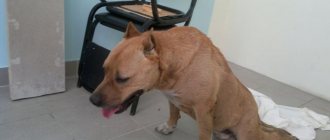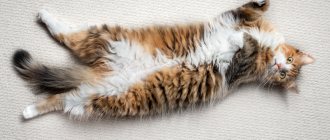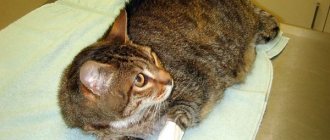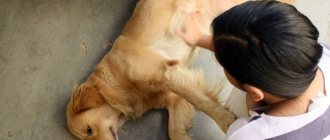Sometimes pet lovers are faced with the following situation: a cat’s back legs have failed. Paralysis or paresis of the limbs is a neurological symptom of serious pathologies of the body. The list of them is very diverse and affects a variety of organs and systems. In the early stages, this condition may be reversible. Therefore, if a cat drags its paw, early contact with a veterinarian significantly increases the likelihood of recovery. One can hope that over time the animal will again feel the joy of movement. From this article you will learn what to do if your pet loses its hind legs, why this can happen and how to help your cat at home.
The importance of differential diagnosis
If a cat's hind legs fail, it is quite difficult to find out the reasons for this. There is a belief that almost all diseases can cause complications and forced limitation of movement.
If a cat does not walk, it can be difficult to distinguish between paralysis of the paws and severe pain that occurs when moving. Perhaps he, experiencing pain when walking, simply refuses to make efforts, since they bring additional discomfort. The causes of severe pain in the back or abdominal area may be the following ailments:
- urolithiasis disease;
- tumor diseases;
- inflammation of the urinary and reproductive system;
- intestinal obstruction.
A distinctive feature of these diseases is that the cat’s paws retain full sensitivity and nerve conduction is not impaired.
Signs of limb failure
You can notice a cut or paralysis of the limbs in your pet based on various obvious signs. The most striking thing is that the pet slightly pulls one or both paws behind it, and the gait also becomes not as confident as that of a healthy animal, and painful sensations arise when leaning on the paws. It is very important to take a close look at your pet's behavior. The main signs of paralysis include the following:
- The gait becomes very unsteady, affecting mainly the back of the body.
- The animal is not able to maintain normal balance, and performs all movements somewhat slowly.
- There is a slight weakness in the cat's hind legs, which later develops into complete muscle failure.
- The animal can very often sit on the back. Most often, this behavior can be observed in old animals.
- The cat moves by dragging its paws behind it and without lifting them off the floor.
- In general, the animal’s mobility is noticeably reduced.
All of the above reasons are a warning sign that the animal may have problems with the musculoskeletal system. Delay in treatment or self-medication can lead to very serious consequences, so it is very important to consult a specialist in a timely manner.
The main causes of the disease
The main causes of partial or complete paralysis of the hind legs are the following pathologies:
- consequences of spinal injuries and traumatic spinal cord injuries;
- intervertebral disc prolapse;
- inflammatory diseases of the spinal cord;
- arterial thromboembolism;
- fibrocartilaginous embolism;
- vitamin deficiency and potassium metabolism disorders;
- hip dysplasia;
- cardiomyopathy and fibrosis of the heart muscle;
- consequences of stroke;
- nutritional hyperthyroidism;
- consequences of ixodid tick bites.
Consequences of spine and spinal cord injuries
When a cat has a fracture, dislocation of the spine, or severe contusion of the spinal cord, a post-traumatic reaction often occurs - the hind legs are taken away. Paw paralysis may be accompanied by painful shock, loss of consciousness, and fecal and urinary incontinence. With proper treatment and the absence of complications, the animal’s condition is usually reversible and after restoration of nerve conduction, sensitivity gradually returns.
Such serious pathologies are treated in most cases in the clinic surgically. Additionally, the doctor prescribes anti-inflammatory, healing and painkillers (Traumel, Milgamma, Baralgin).
Herniated disc
A herniated disc is a protrusion of a disc between the vertebral bodies. Characterized by pain, muscle tension and limited movement. In severe cases, a herniated disc can cause compression of blood vessels, nerve roots and the spinal cord, in which conductivity gradually deteriorates. Because of this, the innervation of the limbs is disrupted, and they can become paralyzed.
If a cat's legs are paralyzed due to this disease, then painkillers, muscle relaxants that relieve severe muscle spasms, decongestants, and vitamins that improve the condition of nerve fibers are prescribed as treatment.
Spinal cord inflammation
The cause of inflammation of the spinal cord (myelitis) can be injuries, complications of infections, helminthic infestations, and poisoning with toxic substances. Such pathologies are usually accompanied by gastrointestinal disorders, severe fever, feelings of anxiety and fear, nausea and vomiting. In addition, the cat's hind legs gradually fail. With myelitis, the condition is usually reversible and after the inflammation is relieved, the animal's limbs regain sensitivity over time.
Treatment consists of prescribing antibiotics, anti-inflammatory drugs, and muscle relaxants. Physiotherapeutic procedures have a good effect.
Arterial thromboembolism
Arterial thromboembolism of the femoral artery is a blockage of the artery by an embolus (a foreign particle circulating through the bloodstream). An embolus can be a particle of clotted blood (thrombus), a parasite, or a piece of tumor. Thromboembolism disrupts the blood circulation in the paws.
The cat does not feel the bloodless limbs; they gradually become cold. The animal screams in pain, refuses to eat and drink, and prefers to be in dark places. The disease often has a poor prognosis, since the likelihood of cure is very low. But in rare cases, with early diagnosis and proper treatment, the disease recedes.
If sensitivity is at least slightly preserved and there is hope, then the animal is given a paw massage, anticoagulants (reducing blood clotting) and physiotherapeutic procedures are prescribed.
Fibrocartilaginous embolism
With fibrocartilaginous embolism, a thrombus clogs the vessels of the spinal cord. Bleeding tissues gradually become necrotic. Severe pain is replaced by a complete lack of sensitivity. Subsequently, the cat's front and hind legs fail. If the blockage of the vessel is incomplete, then the paralysis of the limbs will be partial and then a cure is possible. The main treatment tactics are the prescription of anticoagulants and physical therapy.
Vitamin deficiency and potassium metabolism disorders
A lack of vitamins and minerals in the body that affect the condition of the limbs and their functions can cause paralysis or paresis of the paws. The probable cause of vitamin deficiency is helminthiasis or a poor cat diet. A lack of vitamins A and B1 is especially dangerous. Lack of sunlight can lead to vitamin D deficiency and, as a result, rickets, which is more common in kittens. With paresis, a lack of potassium in the body is often diagnosed.
Vitamin deficiency and micronutrient deficiency can be easily eliminated. After deworming, restoration of a nutritious diet and a course of vitamin therapy, the cat will regain the ability to move independently.
Hip dysplasia
Hip dysplasia is a congenital pathology of the development of the joint, which greatly increases the likelihood of subluxation and dislocation of the femoral head. The disease develops as a result of genetic predisposition or intrauterine developmental defects. Young animals are more susceptible to it. There is also a breed predisposition (Maine Coon cats are more often affected).
This disease is not associated with loss of sensation and paralysis. The animal cannot walk due to a joint malformation. The main symptoms of the disease are:
- limb weakness;
- inability to jump;
- tilting to the side of the affected joint, frequent falls;
- unsteady gait.
The therapy consists of limiting the cat's movement in order to reduce the load on the sore paws and prescribing special food containing glucosamine and chondroetin, as a building material for the cartilage tissue of the joints.
Cardiomyopathy and fibrosis of the heart muscle
Cardiomyopathy is a group of myocardial diseases caused by dystrophic and sclerotic changes in cardiac cells - cardiomyocytes. It often leads to thickening of the heart walls and decreased volume of the ventricles, causing the heart to pump less blood. The animal begins to suffer from oxygen starvation. Main symptoms:
- dyspnea;
- decreased physical activity;
- cough and vomiting;
- refusal to eat.
Paralysis of the hind legs is not typical for cardiomyopathy, but as a secondary disease, thromboembolism can develop, which is the direct cause of paralysis. In addition, the cat is often unable to move due to severe weakness.
Cardiomyopathy can be a form of fibrosis of the heart muscle. Fibrosis is the proliferation of connective tissue and the appearance of scars on organs. Cardiac fibrosis is an irreversible process. The main goal of therapy is to stop the development of the process and treat the underlying disease.
The main drugs used for cardiomyopathy are beta blockers (Atenolol, Propranolol); calcium channel blockers (Diltiazem), which relieve stress on the heart muscle.
Consequences of a stroke
A stroke in cats can be accompanied by a number of symptoms, including paralysis of not only the limbs, but also other parts of the body. For example, impaired swallowing and breathing function. In addition, loss of consciousness, disorientation, and shock are typical. Whether the animal can be saved depends on how quickly medical assistance is provided. In severe cases, paralysis of all muscles is possible. The sooner the improvement occurs, the more favorable the prognosis for recovery.
Nutritional hyperparathyroidism
The disease is a metabolic disorder in which, due to an unbalanced diet, the body develops a lack of calcium, vitamin D and an increased content of phosphorus. As a result, the parathyroid gland secretes too much so-called parathyroid hormone. The main symptoms of hyperparathyroidism relate to the structure and function of the limbs, including:
- lameness;
- bone deformation;
- pathological fractures;
- strong pain;
- cramps of the hind limbs.
The cat's legs spread apart when walking, and eventually she gives up trying to walk.
The main treatment is to limit the cat’s ability to move and switch to a nutritious diet that replenishes the deficiency of important microelements. The prognosis is usually favorable; after recovery, the feeling of numbness in the legs gradually disappears.
Consequences of tick bites
Numerous ixodid tick bites are very dangerous for cats. They carry with them many dangerous diseases: piroplasmosis, tularemia, encephalitis. Not least of all is tick paralysis.
Tick paralysis occurs when poisoned by insect toxins, if the animal is attacked by several individuals at once. Main symptoms: agitation, anxiety, which turns into apathy and indifference. At this stage, paralysis of the limbs may also occur. Treatment is effective only in the early stages of the disease.
To protect the animal, it is necessary to periodically treat it with special anti-tick drops. In addition, you need to know how to get rid of an embedded tick yourself if medical help is not available:
- Treat the area where the insect has attached itself, lubricate it with an airtight liquid (oil, cream). A choking tick will significantly weaken its grip.
- Using tweezers and a magnifying glass, first remove the head and then, in pairs, the legs of the insect from the skin.
- Lubricate the tick with oil again, and after a while, using a loop made of thin thread, pull out the insect. Treat the cat's bleeding wound.
Prevention of lameness
To prevent lameness, proper, balanced feeding of kittens is necessary (with industrial kitten food, or a homemade diet compiled together with a veterinary nutritionist), hygiene in breeding breeds prone to hereditary pathologies (Maine Coons, Scots, etc.), and careful attention to the pet , clinical examination in order to notice the occurrence of a problem in the early stages.
The cat is limping on its hind legs - video with a veterinary rehabilitologist about possible causes:
(c) Veterinary center for the treatment and rehabilitation of animals “Zoostatus”. Varshavskoe highway, 125 building 1. tel.
8 (499) 372-27-37
Diagnosis of paw paralysis
If the initial examination is not enough to determine the cause of paw paralysis, then the following diagnostic methods are used:
- determination of neurological reactions;
- X-ray of the spine and affected limbs;
- Ultrasound of the abdominal cavity;
- detailed blood and urine analysis;
- taking smears for bacteriological analysis;
- MRI and CT scans of areas of the body where pathology is suspected to exist (spine, abdominal cavity, brain);
- determining the level of sensitivity of the affected limbs.
General restorative home treatments for paralysis of paws
If a cat's hind legs have failed, he will benefit from daily restorative procedures. The owner can easily work with the pet on his own at home.
- Paw massage should be done 5 to 7 times a day. For 10-15 minutes, massage your limbs with light but intense movements. This will help restore the conduction of nerve impulses and prevent the muscles from atrophying.
- Therapeutic gymnastics in the form of forced flexion and extension of the limbs is very useful.
- You can imitate walking using a kind of walker, which can be made from a wide towel placed under the cat’s belly. By supporting the animal in this way, you need to provoke it to move its paws on its own. If it is difficult for him, you can help with your hands.
- Swimming gives very good results if the cat is not afraid of water. Once in a pond or bathtub, the animal involuntarily moves its paws, trying to swim, while the owner holds it under its belly. It has been noticed that healing occurs much faster after a course of such exercises.
- Tickling the paws will help the owner feel the moment when the animal begins to feel them, by reaction to irritation.
- Exercises on the ball are effective. The cat is placed on a ball of suitable size. Her paws, hanging down, should almost touch the floor, so that when she rolls, she seems to stand on them.
If the cat’s treatment does not bring the expected effect, and it still drags its hind legs, then you should not euthanize the animal. There is a way out in this case too. There are specialized wheelchairs for cats that perform the functions of limbs. Once accustomed, the cat will be able to move quite quickly in such a stroller without the help of the owner. The quality of life of an animal when using such a device remains quite high.
Treatment method and prognosis
Many pet owners are convinced that if their cat is paralyzed, the only humane way to put it out of its misery is euthanasia. This is only partly true. Indeed, if the condition is serious, then in order not to torment the cat, it is wiser to euthanize it. However, this measure is considered as an extreme measure.
If it is possible to identify the cause that provoked the paralysis, treatment is aimed at eliminating it, and, perhaps, the pet will be cured even without consequences. One or more operations at the veterinary clinic may be required, followed by a long recovery period.
Surgery is required for hernias and some injuries, such as when bone fragments protrude from the wound.
In addition, depending on the etiology of paralysis, the veterinarian prescribes sedatives, non-steroidal anti-inflammatory drugs (Rimadyl, Carprodil, Flexoprofen), anticoagulants (Clopidogrel, Heparin, Aspirin), and antibiotics to relieve pain. If the animal experiences severe pain, the use of opioid drugs (Fentanyl, Hydromorphone) cannot be ruled out.
For inflammatory processes and injuries, steroidal anti-inflammatory drugs are indicated. Metipred, which is administered by drip, has proven itself well. For tick bites, treatment is etiotropic.
Strengthening therapy includes the use of vitamins, in particular group B, which help restore damaged peripheral nerve endings.
If you become dehydrated, you need to replenish lost fluid using a dropper. If the animal has difficulty breathing, oxygen therapy is necessary.
The prognosis for complete or partial paralysis is variable, depending on many reasons - the age and condition of the animal, the degree of damage, etc.
